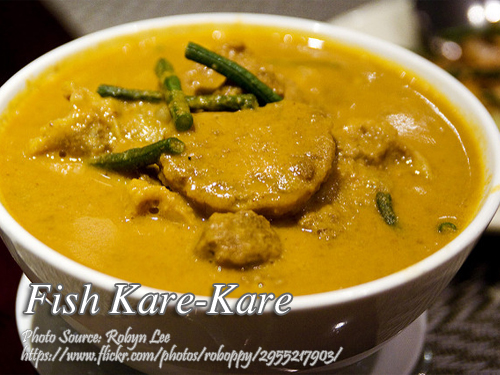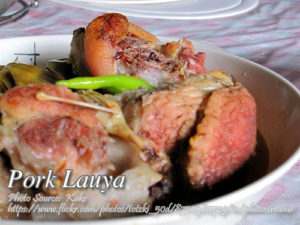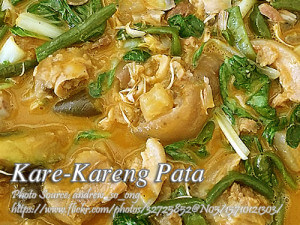Fish kare kare is a healthier version of the traditional meat based kare-kare. Even though this dish is loaded with vegetables, it contains meat such as oxtail, beef tripe, beef or sometimes pork knuckles, that is, the usual kare-kare. But the fish kare-kare as I’ve said is healthier because fish is rich in omega 3 instead of saturated fat in beef or pork. And about the kind of fish used in this kare-kare, labahita fillet is a perfect choice.
Fish Kare Kare: A Healthier Twist on a Filipino Classic
Growing up in Tarlac, kare-kare was always a staple at family gatherings. My Lola Ising would spend hours preparing the dish, slow-cooking oxtail and beef tripe until they were melt-in-your-mouth tender. But as I got older and started paying more attention to healthier eating, I discovered an alternative that satisfied my cravings without the guilt—fish kare kare.
I first learned about this version from my Uncle Rudy, a fisherman from Cavite who swore that labahita, or surgeonfish, made the perfect substitute for beef. He said the fish’s firm texture held up well in stews, absorbing all the peanut sauce goodness while keeping the dish light and rich in omega-3s. It was a game-changer, and now, I rarely make kare-kare any other way.
Why Fish Kare Kare is a Must-Try
Traditional kare-kare is known for its thick peanut sauce, made richer with the gelatin from slow-cooked meat. But let’s be honest—it can be quite heavy. That’s where fish kare kare comes in. By swapping out beef or pork with fish, you still get the nutty, creamy sauce but with less saturated fat. Plus, the addition of vegetables like eggplant, sitaw (string beans), and banana blossoms makes it even more nutritious.
My Ate Liza, a nutritionist, always reminds me that seafood-based dishes are excellent sources of good fats, which are heart-friendly. This means you can enjoy this Filipino comfort food more often without worrying about cholesterol levels.
Cooking Tips That Make a Difference
When my cousin Bebot, who runs a small carinderia in Laguna, taught me her version of fish kare kare, she shared a few essential tips that made all the difference. First, marinating the fish in calamansi juice, salt, and pepper before frying is crucial. This not only removes any unwanted fishy taste but also infuses the meat with a subtle tang that balances the richness of the peanut sauce.
Coating the fish in cornstarch before frying is another step I never skip. This creates a thin, crispy crust that protects the delicate fish, preventing it from falling apart when mixed into the sauce. The contrast between the crispiness of the fish and the creamy sauce is absolutely divine.
The Secret to a Flavorful Sauce
The heart of any kare-kare is the sauce. My Nanay, who still cooks the best kare-kare in our family, always emphasizes the importance of atsuete (annatto) in achieving that signature golden hue. Some people use artificial food coloring, but nothing beats the earthy, slightly peppery taste of natural annatto extract.
For a smoother sauce, I take my time sautéing the garlic and onions before adding water. This allows the flavors to develop before I mix in the peanut butter and seasonings. Using natural peanut butter gives the best taste, but if you’re in a pinch, the commercial sweetened version works too—just adjust the sugar accordingly.
Pairing with Bagoong: A Must for Any Kare Kare
It’s almost a crime to eat kare-kare without bagoong alamang (fermented shrimp paste). The rich, nutty sauce needs that punch of umami to truly shine. I remember my Tita Nena, who came from Pampanga, always making her own bagoong from scratch. She’d sauté it with garlic, onions, and a bit of sugar, creating a deep, savory complement to the kare-kare.
For fish kare kare, I like to serve the bagoong on the side, so everyone can adjust the saltiness to their preference. Some like it mild, while others (like my Tito Boy, who has an iron stomach) pile it on without hesitation.
A Dish That Brings People Together
Whenever I cook fish kare kare, I’m reminded of how Filipino food is more than just sustenance—it’s a shared experience, a way of keeping family traditions alive. I can still picture Sunday lunches at Lolo Pabling’s house, where the whole clan would gather around a table full of home-cooked dishes, arguing over who got the last piece of fish.
If you’ve never tried this seafood twist on kare-kare, now’s the time. It’s a lighter, healthier version that still captures everything we love about this beloved dish. Just don’t forget the bagoong and an extra cup of rice—you’ll need it.
How to Cook Fish Kare-Kare (Labahita)
Ingredients
- 3/4 kilo labahita deboned and cut into large cubes
- 2 Tbsp. rice flour
- 1/2 cup cornstarch
- 1/2 cup toasted peanuts pounded
- 6 cloves garlic crushed
- 3 heads native pechay
- 1 pc medium onion chopped
- 1 Tbsp. calamansi juice
- 5 strings sitaw (string beans) 100grams, cut into 2" pieces
- 1/3 tsp iodized salt or 1 tsp rock salt
- 1 pc medium puso ng saging banana heart, sliced
- 1/4 tsp pepper
- 3 pcs medium eggplants sliced
- 1 to 1/2 cups water
- 1 Tbsp. atsuete juice
- 1 tsp. sugar
- 1 can 140 grams Tomato Sauce
- Cooking oil for frying
- Bagoong alamang or shrimp paste sauteed
Instructions
How to Cook Fish Kare Kare
- Marinate labahita cubes in calamansi juice, iodized or rock salt and pepper for 30 minutes.
- Coat each piece with cornstarch, then fry in oil until golden brown. Set aside.
- Saute onion and garlic in oil. Add water, sitaw, puso ng saging, eggplant and atsuete juice.
- Season with salt, pepper and sugar according to taste. Simmer for 20 minutes.
- Add the rest of the ingredients except fish.
- Simmer, stirring occasionally, until pechay is cooked.
- Add fish just before serving. Serve with sauteed bagoong alamang.
Notes
Cooking Tips:
Marinate the Fish for Better Flavor
Before frying, marinate the fish in calamansi juice, salt, and pepper for at least 30 minutes to remove any unwanted fishy taste. The acidity from the calamansi helps tenderize the fish while adding a subtle tang that balances the richness of the peanut sauce. Skipping this step may result in a bland and slightly off-putting flavor.Coat the Fish for a Crispier Texture
Lightly coat the fish in cornstarch before frying to create a delicate crust that helps it stay intact when mixed into the sauce. This adds a pleasant contrast to the creamy peanut sauce, making each bite more enjoyable. Without this step, the fish may break apart and lose its texture in the stew.Use Natural Atsuete for Authentic Color
Instead of using artificial food coloring, extract the natural hue from atsuete (annatto seeds) by soaking them in warm water or sautéing in oil. This gives the kare-kare its signature golden-orange color while adding a mild earthy flavor. Artificial coloring may mimic the look, but it won’t enhance the taste the way natural atsuete does.






Hi, would like to try this recipe, but may I know what ingredient this is: 1 can (140grams) Del Monte ?? Thanks. Your recipes are great 🙂
Hi Arlene, oops! there is an error on that part. It is 140 gram can Del Monte tomato sauce which I corrected already. Please see the recipe again. Thanks for your feedback!